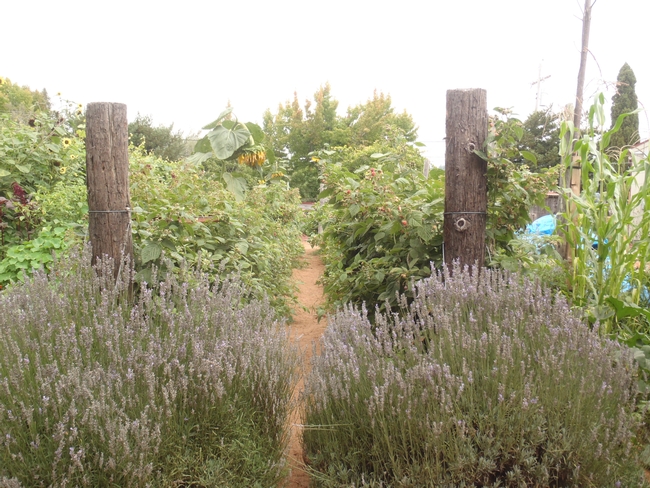Posts Tagged: wildflower
A 'Page' in an Important Chapter on Wild and Managed Bees
Congratulations to doctoral student and pollination ecologist Maureen Page of the Neal Williams lab, UC Davis Department of Entomology and...

UC Davis doctoral student and pollination ecologist Maureen Page has received prestigious three-year fellowship, a National Defense Science and Engineering Graduate Fellowship, funded by the Department of Defense.
You're An Obsession, My Obsession
My current gardening obsession is hunting for nurseries and resources that carry perennial vegetables. Such plants are usually available in the U.S. during the Spring (they are currently available at this time of year in Australia), but being the impatient personality that I am, I am anxious to get going now.
But this post is not about perennial vegetables—that will come in a later post once I succeed in acquiring said unusual and rare plants (such vegetables will go well beyond asparagus and artichoke), which may occur sometime in August (if you are interested, see www.oaec.org). It was my pursuit of these perennial vegetable plants that led me to recently stumble across a wonderful bakery and a small edible garden tucked behind it, which is the subject of this post.
So you ask—where is this place where one can find both amazing food and a beautiful garden? The answer--in Freestone located in Sonoma County. The bakery is called “Wild Flour Bakery” and features tasty creations such as sticky bun bread, scones dotted with strawberry and white chocolate, and savory goods (see http://www.wildflourbread.com/). The garden behind the bakery is cleverly named “Wild Flower Gardens” (play on the word “Flower” and “Flour”) which I suspect supplies some of the fruit used in the bakery’s baked goods. Unlike many edible gardens that can become overgrown because there is so much to manage, Wild Flower Gardens is, on the whole, well-ordered. In that space, you will find a small grove of young fruit trees consisting mostly of pears and plums. Also, in that space, are edible plants (kale, lettuce, raspberries, grapes, herbs, etc.) combined with ornamentals, the arrangement of which always interests me, because I enjoy seeing how people integrate these seemingly disparate groups of plants so that they look harmonious together. Best of all, there is seating scattered throughout the garden where you are invited to bring your fresh baked goods in to sit down and enjoy. It is a great little weekend getaway, just slightly over an hour from Solano County--not to be missed!

Rows of vegetables. (photos by Betty Homer)

Lavendar and berries flank this pathway.

Grapevines above and nasturtiums below-enter at your own delight.

Sunflowers, and plumes of Amaranth in the background with cabbages in the fore.
California Gold
You have probably seen them. They are peeking out from under bushes in yards around town, beginning to wave like so many little orange-gold flags along drives and on hillsides around the state. Yes, the California Poppy (Eschscholzia californica) is making its yearly debut.
This little poppy is native not only to California, but also to Oregon and grows in all zones therein. It is actually a perennial, but most people use it as an annual in the garden. After the blooms fade the plant dries and looks quite weedy, so you have several choices. You can just pull out the plants, leaving the spot tidy and ready for something else. If you do, however, you will need to reseed next year if you want poppies again. Or you can leave the plants and let them go to seed naturally. The seeds form on long, slender, arching pods. If you happen to be out in the garden when the pods open you will hear a gentle "pop" and then a soft rain as the seeds fall to earth. (I was delighted the first time I heard it and realized what it was.) Once the pods have popped you can safely pull the dried plants to neaten your garden, knowing that your next year's crop has been seeded. One caution, however: mine are on a slight slope facing west and many of the seeds over the years have landed on the sidewalk. A good sweep with the broom sends them back where I want them. OR you can cut the plants back almost to the ground and they are very likely to grow again the following spring.
I planted my poppies as part of a wildflower mix some 20 years ago and have enjoyed their returning blooms ever since. In the last few years, however, I have pulled out plants a little early and not been so careful about the seeds--probably because I have always had a glorious display and felt "poppy wealthy". Perhaps due to that cavalier attitude combined with the scarce rainfall this winter, I have very few poppies in my yard so far this year. Still, I smile as I can see poppies in several of the yards up my street where the wind has shared my poppy seeds.
The Antelope Valley boast hillsides covered with poppies every spring. Nearby the city of Lancaster holds a California Poppy Festival (this year on April 20-21), celebrating with music, art, food and fun our state flower.
Our official California Master Gardener emblem, Eschscholzia californica was named circa 1810 by a German botanist after his friend Johann Friedrich von Eschscholtz had brought it back from a scientific expedition to the Pacific. It was chosen by the California State Floral Society as the state flower in 1890 and made official by the legislature on April 6, 1903. Happy 110th anniversary, little gem!

Beautiful poppies. photos by Marian Chmieleski

ca poppy close up

mini ca poppies
Sun Break: Here Come the Bees
The Tidy Tips are a'blooming and the bees are a'buzzing. The Tidy Tips, a native California wildflower (Layia platyglossa, family Asteraceae) is a...

Honey Bee on Tidy Tips

Close-up

